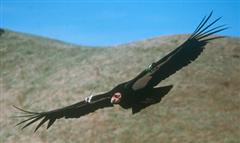Vulture - california condor
California Vulture Scientific Name: Gymnogyps californianus
Thu, 9th January, 2025 - 4:02 am GMT
Sponsor Ads:

Alternative Name
California Vulture Scientific Name: Gymnogyps californianusBasic Info
N/A
Health
Breeding California Condors begin breeding at seven or eight years of age and lay their eggs in gravel patches of caves or cliffs. These Condors do not breed every year and lay only one egg between February and May. Both parents incubate the egg, which will hatch after about 59 days. Both parents also feed the hatchling with regurgitated material. At five to seven months, the baby California Condor will begin to fly but will not be independent until it is more than one year of age.Habitat
Arid regions of California and Arizona and in zoosBehavior
The California Condor is the largest bird in North America and at one point was nearly extinct. In the 1980's, the population had dropped to 20 of these Condors, but now, thanks to captive breeding programs, the California Condor is making a comeback. Frequenting isolated, rocky ledges and cliffs in the Southern United States, the California Condor is a bird whose diet consists mostly of carrion. Occasionally the Condor will take a rodent or fish, but its talons are too weak to kill anything else. After eating, the California Condor is too heavy to fly and must remain on the ground, where they fastidiously clean themselves by rubbing their heads and necks on vegetation or rocks. Condors can go for days without eating, but when they do eat, may ingest up to two pounds of food! California Condors also bathe frequently and sun themselves dry. Their nests are usually simply gravel scrapes in caves or rock outcroppings, and the word "nest" is rather inappropriate in describing it. California Condors make wheezing or grunting noises to communicate. Occasionally, California Condors fly into power lines and are killed, and human destruction of their habitats has been a crushing blow for these beautiful birds. The loss of these gentle creatures has been prevented only through the strenuous and dedicated efforts of many wildlife funds, zoos and individuals.Origin
North AmericaHistory
California Condors once ranged over the entire Southwestern United States but now reside only in arid regions of California and Arizona and in zoos. Traditionally, they were revered as sacred birds by Native Americans and may have been used in rituals, but with the European settlement of the West, became nearly extinct. Pesticides like DDT in addition to poaching, habitat loss and poisoning killed off a huge number of Condors. Protected by the Endangered Species Act, their numbers had nevertheless dwindled down to 22 wild birds in 1987. Captive breeding programs have had phenomenal success at reintroducing these birds into the wild and now 120 California Condors are in existence.Common Foods
Usually feeding on dead buffalo, deer, or other large carcasses, Condors provide a valuable service in waste disposal. In captivity, California Condors are fed dead cattle and sheep.Sponsor Ads:
It is when the irritation of doubt causes a struggle to attain belief that the enterprise of thought begins. -- Unknown
Vulture - california condor
Coded by: BGID® | ALL RIGHTS RESERVED Copyright © 2000-2025
Disclaimer | Privacy | Report Errors / Contact | Credits


 Preparing For China. China is growing their military. China Military Technology - can it keep up with the US?
Preparing For China. China is growing their military. China Military Technology - can it keep up with the US?  versus
versus 

 versus
versus 
 This Thread is about the North Korean Military itself - the kind of army, navy, and air force they have.
This Thread is about the North Korean Military itself - the kind of army, navy, and air force they have. 
 versus
versus 
 versus
versus  versus
versus